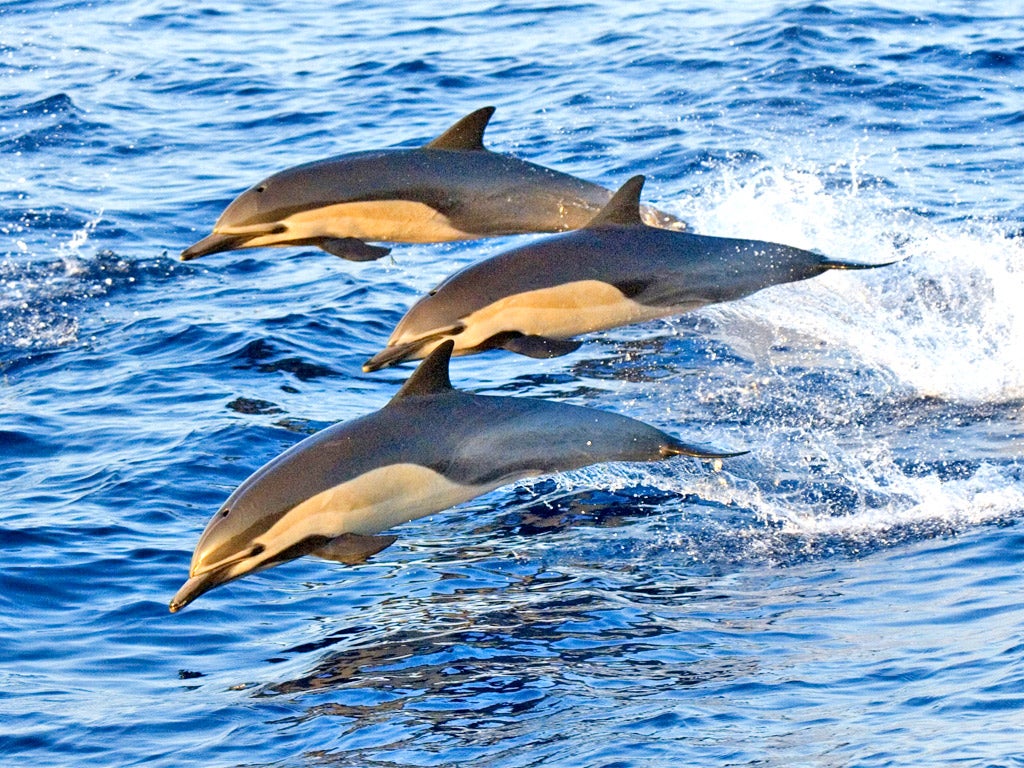Nature Studies by Michael McCarthy: The unbearable lightness of dolphins

Tomorrow is my annual expedition to look for purple emperor butterflies in a wonderful Wiltshire oakwood, much anticipated, but the weather forecast is dire, and downpours will wash away any chance of catching those resplendent purple wings glinting around the tree canopy or even coming down to the ground. I feel the need for a word like Bah! (used by frustrated villains in the comics of my youth) or perhaps even Curses! The appalling sodden summer of 2012 has cast a pall over a number of such wildlife watching opportunities (and, more importantly, done a lot of real harm to the wildlife itself).
Yet there is one such opportunity which by its nature is unaffected by the wet, however wet the wet be, and that is whale-watching, which I use in the broad sense of seeking out all types of cetaceans – whales, dolphins and porpoises.
On Monday, I am taking the children to Harris in the Outer Hebrides, and although I love everything about the Western Isles, whale-watching is what they are most looking forward to. My daughter is 20 now and my son 16, but they are still thrilled, as they have been for more than a decade, by the cetacean encounters we have tried to build into our holidays.
Some have been spectacular. Perhaps the best of all was in the Sporades, those northerly Greek islands which include Skopelos where they filmed Mamma Mia! We had sailed out from Alonissos on a tourist sailing boat, a kaiki, and near the remote island of Kyra Panagia, when the sea was absolutely still, flat as a mirror it was, a pod of common dolphins suddenly burst out of the surface and for five minutes played around the boat, enthralling every soul on board. They were doing it for fun, just for the hell of it, which made it all the more captivating.
The common dolphin, Delphinus delphis, is a more handsome beast than the cousin we commonly see around the British coast, the bottlenose dolphin, Tursiops truncatus, as it has a broad pale lateral stripe which makes it seem glamorously streamlined. (It looks striking in the ancient frescoes of the palace of Knossos in Crete.) You can find it in British waters, though – last spring, staying on Skye, we encountered a pair which had taken up residence by the fish farm in Loch Carron, north of Kyle of Lochalsh, and they put on a similar, charming tease-the-boat performance.
But bottlenose dolphins are just as thrilling to the children. In Britain, we have two resident populations, in Cardigan Bay and the Moray Firth, and we have seen the Welsh animals, delighting in a mother with a small calf who came close to the boat, which sails out of the little port of New Quay.
Off the Hebrides next week, we are hoping for bigger things: minke whales, perhaps, and, top of the list, killer whales or orcas, which we have never seen. I often wonder why the cetacean attraction is so intense, especially for children, although I feel it keenly myself. Perhaps it's to do with the way their appearances are so unpredictable, how they can suddenly materialise out of the waves and then just as suddenly vanish into the endless expanse of the ocean, so any close sighting leaves you feeling privileged.
But also, the animals themselves are fantastic. Their intelligence is obvious, and when they really turn on the playfulness, buzzing the boat in a dance that seems to take the act of swimming to an entirely new level, they spark a fellow-feeling in us: we laugh along with them.
Feeling browned off with the summer? Or, indeed, feeling washed out? Try a little whale-watching. Last year, we published in The Independent a whale-watcher's guide to Britain and if you want to have a look at what's on offer, here's a quick link to the guide: tinyurl.com/3jk4hag.
It's one piece of summer happiness that can't be rained off.
Two cetaceans close to the edge of extinction
Not everything is well in the whale and dolphin world. Although the immediate threats to most of the great whales have subsided with the 26-year-old commercial whaling moratorium, two smaller cetaceans are among the most critically endangered of all mammals: the vaquita porpoise of Mexico and Maui's dolphin of New Zealand.
The vaquita, which inhabits the Gulf of California, is thought to be down to fewer than 200 individuals, while the Maui's dolphin, found off the west coast of North Island, may only have 50 or so adult animals remaining. Unless action is taken both are set to follow the baiji, China's Yangtze river dolphin, into extinction.
At last week's International Whaling Commission meeting in Panama, a resolution was passed calling for fishing nets to be kept out of the home waters of both Maui's dolphin and the vaquita. Both animals are severely threatened by their accidental bycatch in gillnet fisheries. A total ban on the use of gillnets in the entire ranges of both populations is needed to secure their survival, according to the IWC Scientific Committee.
A glimmer of hope, perhaps.
Join our commenting forum
Join thought-provoking conversations, follow other Independent readers and see their replies
Comments
Bookmark popover
Removed from bookmarks